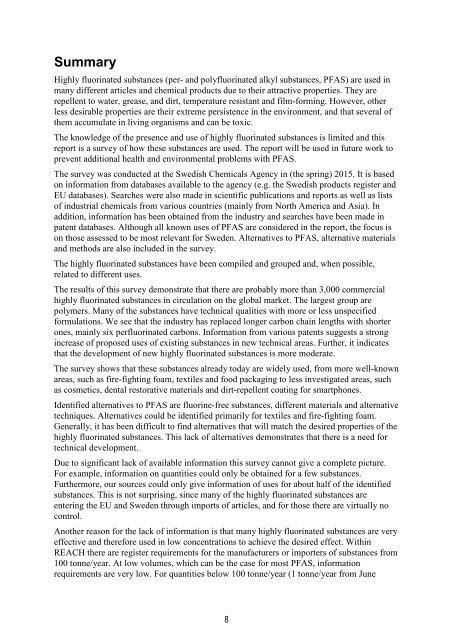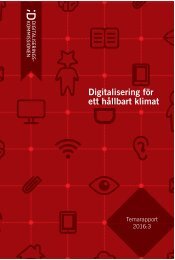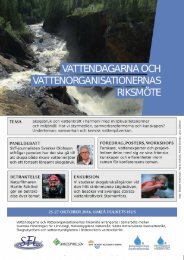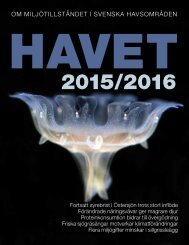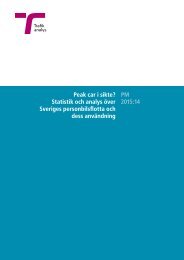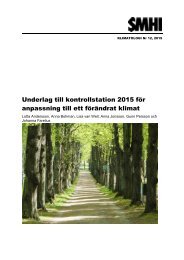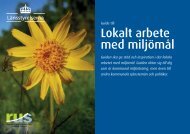RAPPORT
rapport-6-15-forekomst-och-anvandning-av-hogfluorerade-amnen-och-alternativ
rapport-6-15-forekomst-och-anvandning-av-hogfluorerade-amnen-och-alternativ
Create successful ePaper yourself
Turn your PDF publications into a flip-book with our unique Google optimized e-Paper software.
Summary<br />
Highly fluorinated substances (per- and polyfluorinated alkyl substances, PFAS) are used in<br />
many different articles and chemical products due to their attractive properties. They are<br />
repellent to water, grease, and dirt, temperature resistant and film-forming. However, other<br />
less desirable properties are their extreme persistence in the environment, and that several of<br />
them accumulate in living organisms and can be toxic.<br />
The knowledge of the presence and use of highly fluorinated substances is limited and this<br />
report is a survey of how these substances are used. The report will be used in future work to<br />
prevent additional health and environmental problems with PFAS.<br />
The survey was conducted at the Swedish Chemicals Agency in (the spring) 2015. It is based<br />
on information from databases available to the agency (e.g. the Swedish products register and<br />
EU databases). Searches were also made in scientific publications and reports as well as lists<br />
of industrial chemicals from various countries (mainly from North America and Asia). In<br />
addition, information has been obtained from the industry and searches have been made in<br />
patent databases. Although all known uses of PFAS are considered in the report, the focus is<br />
on those assessed to be most relevant for Sweden. Alternatives to PFAS, alternative materials<br />
and methods are also included in the survey.<br />
The highly fluorinated substances have been compiled and grouped and, when possible,<br />
related to different uses.<br />
The results of this survey demonstrate that there are probably more than 3,000 commercial<br />
highly fluorinated substances in circulation on the global market. The largest group are<br />
polymers. Many of the substances have technical qualities with more or less unspecified<br />
formulations. We see that the industry has replaced longer carbon chain lengths with shorter<br />
ones, mainly six perfluorinated carbons. Information from various patents suggests a strong<br />
increase of proposed uses of existing substances in new technical areas. Further, it indicates<br />
that the development of new highly fluorinated substances is more moderate.<br />
The survey shows that these substances already today are widely used, from more well-known<br />
areas, such as fire-fighting foam, textiles and food packaging to less investigated areas, such<br />
as cosmetics, dental restorative materials and dirt-repellent coating for smartphones.<br />
Identified alternatives to PFAS are fluorine-free substances, different materials and alternative<br />
techniques. Alternatives could be identified primarily for textiles and fire-fighting foam.<br />
Generally, it has been difficult to find alternatives that will match the desired properties of the<br />
highly fluorinated substances. This lack of alternatives demonstrates that there is a need for<br />
technical development.<br />
Due to significant lack of available information this survey cannot give a complete picture.<br />
For example, information on quantities could only be obtained for a few substances.<br />
Furthermore, our sources could only give information of uses for about half of the identified<br />
substances. This is not surprising, since many of the highly fluorinated substances are<br />
entering the EU and Sweden through imports of articles, and for those there are virtually no<br />
control.<br />
Another reason for the lack of information is that many highly fluorinated substances are very<br />
effective and therefore used in low concentrations to achieve the desired effect. Within<br />
REACH there are register requirements for the manufacturers or importers of substances from<br />
100 tonne/year. At low volumes, which can be the case for most PFAS, information<br />
requirements are very low. For quantities below 100 tonne/year (1 tonne/year from June<br />
8


